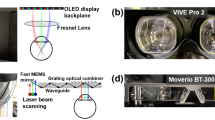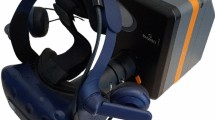Abstract
Mixed reality technologies provide more natural interaction with virtual objects integrated in physical environments. Considering global lighting conditions, the spatial mapping has limitations, which manifest when scanning under limited light intensity. This paper evaluates the impact of red, green and blue monochromatic lighting sources on the spatial map scanning and distance measurement process of the Microsoft HoloLens holographic computer and head-mounted display. The paper also compares luminous power values, measured by MS HoloLens, with the ones obtained from a professional luminous flux meter.
Access this chapter
Tax calculation will be finalised at checkout
Purchases are for personal use only
Similar content being viewed by others
References
Aguilar, W.G., Rodríguez, G.A., Álvarez, L., Sandoval, S., Quisaguano, F., Limaico, A.: Real-time 3D modeling with a RGB-D camera and on-board processing. In: De Paolis, L.T., Bourdot, P., Mongelli, A. (eds.) AVR 2017. LNCS, vol. 10325, pp. 410–419. Springer, Cham (2017). https://doi.org/10.1007/978-3-319-60928-7_35
Anandapadmanaban, E., Tannady, J., Norheim, J., Newman, D., Hoffman, J.: Holo-SEXTANT: an augmented reality planetary EVA navigation interface. In: 48th International Conference on Environmental Systems (2018)
Brown, L.: Holographic micro-simulations to enhance aviation training with mixed reality. Technical report, Western Michigan College of Aviation (2018)
Galko, L., Porubän, J.: Tools used in ambient user interfaces. Acta Electrotechnica et informatica 16(3), 32–40 (2016)
Ghosh, A., Ranjan, R., Nirala, A., Yadav, H.: Design and analysis of processing parameters of hololenses for wavelength selective light filters. Optik-Int. J. Light Electron Opt. 125(9), 2191–2194 (2014)
Jacobs, K., Loscos, C.: Classification of illumination methods for mixed reality. In: Computer Graphics Forum, vol. 25, pp. 29–51. Wiley Online Library (2006)
Kinateder, M., Gualtieri, J., Dunn, M.J., Jarosz, W., Yang, X.D., Cooper, E.A.: Using an augmented reality device as a distance-based vision aid-promise and limitations. Optom. Vis. Sci. 95(9), 727 (2018)
Korečko, Š., et al.: Assessment and training of visuospatial cognitive functions in virtual reality: proposal and perspective. In: Proceedings of 9th IEEE International Conference on Cognitive Infocommunications (CogInfoCom), Budapest, pp. 39–43 (2018)
Liu, Y., Dong, H., Zhang, L., El Saddik, A.: Technical evaluation of hololens for multimedia: a first look. IEEE MultiMedia 25(4), 8–18 (2018)
Mandl, D., et al.: Learning lightprobes for mixed reality illumination. In: 2017 IEEE International Symposium on Mixed and Augmented Reality (ISMAR), pp. 82–89. IEEE (2017)
Microsoft: Microsoft hololens homepage (2019). https://www.microsoft.com/en-us/hololens
Noor, A.K.: The hololens revolution. Mech. Eng. Mag. Select Articles 138(10), 30–35 (2016)
Rohmer, K., Jendersie, J., Grosch, T.: Natural environment illumination: coherent interactive augmented reality for mobile and non-mobile devices. IEEE Trans. Vis. Comput. Graph. 23(11), 2474–2484 (2017)
Zhang, L., Dong, H., El Saddik, A.: Towards a QoE model to evaluate holographic augmented reality devices: a hololens case study. IEEE MultiMedia (2018)
Acknowledgements
This work has been supported by the APVV grant no. APVV-16-0202: “Enhancing cognition and motor rehabilitation using mixed reality”.
Author information
Authors and Affiliations
Corresponding author
Editor information
Editors and Affiliations
Rights and permissions
Copyright information
© 2019 Springer Nature Switzerland AG
About this paper
Cite this paper
Hudák, M., Korečko, Š., Sobota, B. (2019). Microsoft HoloLens Evaluation Under Monochromatic RGB Light Conditions. In: De Paolis, L., Bourdot, P. (eds) Augmented Reality, Virtual Reality, and Computer Graphics. AVR 2019. Lecture Notes in Computer Science(), vol 11614. Springer, Cham. https://doi.org/10.1007/978-3-030-25999-0_14
Download citation
DOI: https://doi.org/10.1007/978-3-030-25999-0_14
Published:
Publisher Name: Springer, Cham
Print ISBN: 978-3-030-25998-3
Online ISBN: 978-3-030-25999-0
eBook Packages: Computer ScienceComputer Science (R0)




